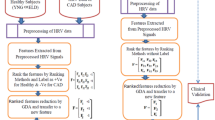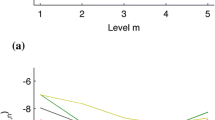Abstract
As far as the mortality of the global population is concerned, it is cardiovascular diseases which cause the highest death rate worldwide, mostly due to the Congestive Heart Failure (CHF). Therefore, an initial detection and diagnosis of CHF becomes essential. This manuscript presents a novel approach to detect health of \(\mathrm{CHF}\) subject which is based on Multiresolution Wavelet Packet (MRWP) decomposition method, attributes ranking approach, kernel principle component analysis \((\mathrm{KPCA})\) and \(1-\mathrm{Norm Linear}\) \(\mathrm{Programming}\) \(\mathrm{Extreme}\) \(\mathrm{Learning}\) Machine \((1-\mathrm{NLPELM}).\) For this investigation, the heart rate variability (HRV) signal has been decomposed up to 5-level using MRWP decomposition method. The sixty three log root mean square (LRMS) attributes were extracted from the decomposed HRV signal. The top ten attributes are selected by ranking approaches such as\(\mathrm{Fisher}\), Wilcoxon,\(\mathrm{Entropy}\),\(\mathrm{Bhattacharya}\), and receiver operating characteristic\((\mathrm{ROC})\). The ten ranked attributes were then mapped to one new feature by KPCA and fed to\(1-\mathrm{NLPELM}\). The \(\mathrm{HRV}\) database of normal subjects (normal sinus rhythm\((\mathrm{NSR})\), age 22–45 years old and elderly (ELY), age 60–82 years old) and CHF subjects (age 32–71 years old) were obtained from PhysioNet ATM. The simulation results demonstrated that \(\mathrm{Bhatacharya}+\mathrm{ KPCA with }1-\mathrm{NLPELM}\) approach achieved an accuracy of\(98.44\pm 1.4\mathrm{\%}\), \(99.13\pm 1.85\mathrm{ \%}\) for \(\mathrm{NSR}-\mathrm{CHF}\) and \(\mathrm{ELY}-\mathrm{CHF}\) respectively. Out of all ranking methods, \(\mathrm{Bhatacharya}\) combined with \(\mathrm{KPCA}+1-\mathrm{NLPELM}\) provided the highest degree of accuracy for all datasets. In addition, the proposed method has also achieved very good generalization performance and less execution time as compared to\(1-\mathrm{NLPELM}\),\(\mathrm{KPCA}+\mathrm{PNN}\), \(\mathrm{KPCA}+\mathrm{SVM}\), probabilistic neural network (\(\mathrm{PNN}\)) and support vector machine (\(\mathrm{SVM})\).








Similar content being viewed by others
Abbreviations
- AI:
-
Artificial intelligence
- ANS:
-
Autonomic nervous system
- CRD:
-
Cardiac resynchronization-defibrillator
- CVDS:
-
Cardio vascular diseases
- CHF:
-
Congestive heart failure
- GDA:
-
Generalized discriminant analysis
- HRV:
-
Heart rate variability
- 1-NLPELM:
-
1-Norm linear programming extreme learning machine
- ELY:
-
Elderly
- ELM:
-
Extreme learning machine
- ECG:
-
Electrocardiogram
- KPCA:
-
Kernel principle component analysis
- LRMSF:
-
Log root mean square features
- ML:
-
Machine learning
- μ1 and μ2:
-
Mean of 1st and 2nd group of Jth attributes (features)
- MRWP:
-
Multiresolution wavelet packet
- NSR:
-
Normal sinus rhythm
- N1:
-
Number of first group attributes
- N2:
-
Number of second group attributes
- PNN:
-
Probabilistic neural network
- RBF:
-
Radial basis function
- ROC:
-
Receiver operating characteristic
- SCA:
-
Sudden cardiac arrest
- SVM:
-
Support vector machine
- β:
-
The weight between hidden node and output
- V1 and V2:
-
Variance of 1st and 2nd group of Jth attributes
- W:
-
Wavelet functions
- WP:
-
Wavelet packet
- G(W,B,X):
-
Activation function(wight, biase, input attribute)
- L:
-
Class label for given attributes
References
Algra A, Tijssen JGP, Roelandt JRTC, Pool J, Lubsen J (1991) QTc prolongation measured by standard 12-lead electrocardiography is an independent risk factor for sudden death due to cardiac arrest. Circulation 83(6):1888–1894. https://doi.org/10.1161/01.CIR.83.6.1888
Aran O, Akarun L (2010) A multi-class classification strategy for Fisher scores: application to signer independent sign language recognition. Pattern Recognit 43(5):1776–1788. https://doi.org/10.1016/j.patcog.2009.12.002
Asl BM, Setarehdan SK, Mohebbi M (2008) Support vector machine-based arrhythmia classification using reduced features of heart rate variability signal. Artif Intell Med 44(1):51–64. https://doi.org/10.1016/j.artmed.2008.04.007
Babaoglu I, Findik O, Ulker E (2010) A comparison of feature selection models utilizing binary particle swarm optimization and genetic algorithm in determining coronary artery disease using support vector machine. Expert Syst Appl 37(4):3177–3183. https://doi.org/10.1016/j.eswa.2009.09.064
Bartlett PL (1998) The sample complexity of pattern classification with neural networks: the size of the weights is more important than the size of the network. IEEE Trans Inf Theory 44(2):525–536. https://doi.org/10.1109/18.661502
Baudat G, Anouar F (2000) Generalized discriminant analysis using a Kernel approach. Neural Comput 12(10):2385–2404. https://doi.org/10.1162/089976600300014980
Bin-Huang G, Chen L, Siew CK (2006) Universal approximation using incremental constructive feedforward networks with random hidden nodes. IEEE Trans Neural Netw 17(4):879–892. https://doi.org/10.1109/TNN.2006.875977
Bin-Huang G, Wang DH, Lan Y (2011) Extreme learning machines: a survey. Int J Mach Learn Cybern 2(2):107–122. https://doi.org/10.1007/s13042-011-0019-y
Braunschweig F et al (2010) Management of patients receiving implantable cardiac defibrillator shocks. Europace 12(12):1673–1690. https://doi.org/10.1093/europace/euq316
Cao J, Lin Z, Bin Huang G, Liu N (2012) Voting based extreme learning machine. Inf Sci (NY) 185(1):66–77. https://doi.org/10.1016/j.ins.2011.09.015
Castiglioni P, Lazzeroni D, Coruzzi P, Faini A (2018) Multifractal-multiscale analysis of cardiovascular signals: a DFA-based characterization of blood pressure and heart-rate complexity by gender. Complexity 2018(1):1–14. https://doi.org/10.1155/2018/4801924
Ding S, Zhao H, Zhang Y, Xu X, Nie R (2015) Extreme learning machine: algorithm, theory and applications. Artif Intell Rev 44(1):103–115. https://doi.org/10.1007/s10462-013-9405-z
Dua S, Du X, Vinitha-Sree S, Thajudin-Ahamed VI (2012) Novel classification of coronary artery disease using heart rate variability analysis. J Mech Med Biol 12(4):1240017. https://doi.org/10.1142/S0219519412400179
Ebrahimzadeh E, Pooyan M (2011) Early detection of sudden cardiac death by using classical linear techniques and time-frequency methods on electrocardiogram signals. J Biomed Sci Eng 04(11):699–706. https://doi.org/10.4236/jbise.2011.411087
Gao Y, Xie Z, Yu X (2020) A hybrid algorithm for integrated scheduling problem of complex products with tree structure. Multimed Tools Appl 79(43–44):32285–32304. https://doi.org/10.1007/s11042-020-09477-2
Giri D et al (2013) Automated diagnosis of coronary artery disease affected patients using LDA, PCA, ICA and discrete wavelet transform. Knowl-Based Syst 37:274–282. https://doi.org/10.1016/j.knosys.2012.08.011
Hallstrom AP, Stein PK, Schneider R, Hodges M, Schmidt G, Ulm K (2005) Characteristics of heart beat intervals and prediction of death. Int J Cardiol 100(1):37–45. https://doi.org/10.1016/j.ijcard.2004.05.047
Hemamalini B, Nagarajan V (2020) Wavelet transform and pixel strength-based robust watermarking using dragonflyoptimization. Multimed Tools Appl 79(13–14):8727–8746. https://doi.org/10.1007/s11042-018-6096-0
Huang G-B et al (2006) Extreme learning machine: theory and applications. Neurocomputing 70(1–3):489–501. https://doi.org/10.1016/j.neucom.2005.12.126
Huang G-B, Ding X, Zhou H (2010) Optimization method based extreme learning machine for classification. Neurocomputing 74(1–3):155–163. https://doi.org/10.1016/j.neucom.2010.02.019
Huang GB, Zhou H, Ding X, Zhang R (2011) Extreme learning machine for regression and multiclass classification. IEEE Trans Syst Man Cybern Part B 4(2):513–529. https://doi.org/10.1109/tsmcb.2011.2168604
Huikuri HV et al (2003) Prediction of sudden cardiac death after myocardial infarction in the beta-blocking era. J Am Coll Cardiol 42(4):652–658. https://doi.org/10.1016/S0735-1097(03)00783-6
Kampouraki A, Manis G, Nikou C (2009) Heartbeat time series classification with support vector machines. IEEE Trans Inf Technol Biomed 13(4):512–518. https://doi.org/10.1109/TITB.2008.2003323
Karimi M (2006) Noninvasive detection and classification of coronary artery occlusions using wavelet analysis of heart sounds with neural networks. IET 20:117–120. https://doi.org/10.1049/ic:20050342
Khushaba RN, Kodagoda S, Lal S, Dissanayake G (2011) Driver drowsiness classification using fuzzy wavelet-packet-based feature-extraction algorithm. IEEE Trans Biomed Eng 58(1):121–131. https://doi.org/10.1109/TBME.2010.2077291
Lal H et al (2020) Machine learning based congestive heart failure detection using feature importance ranking of multimodal features. Math Biosci Eng 18(1):69–91. https://doi.org/10.3934/mbe.2021004
Li S, Wang H, Wang S, Zhang S (2020) Life detection and non-contact respiratory rate measurement in cluttered environments. Multimed Tools Appl 79(43–44):32065–32077. https://doi.org/10.1007/s11042-020-09510-4
Li K, Daniels J, Liu C, Herrero P, Georgiou P (2020) Convolutional recurrent neural networks for glucose prediction. IEEE J Biomed Health Inform 24(2):603–613. https://doi.org/10.1109/JBHI.2019.2908488
Liping X et al (2020) Computational diagnostic techniques for electrocardiogram signal analysis. Sensors 20:6318. https://doi.org/10.3390/s20216318
Martinez AM, Kak AC (2001) PCA versus LDA. IEEE Trans Pattern Anal Mach Intell 23(2):228–233. https://doi.org/10.1109/34.908974
Patel DR (2011) Sudden cardiac death in young athletes. Asian J Sports Med 2(2):120–122. https://doi.org/10.5812/asjsm.34778
Poddar MG, Kumar V, Sharma YP (2015) Automated diagnosis of coronary artery diseased patients by heart rate variability analysis using linear and non-linear methods. J Med Eng Technol 39(6):331–341. https://doi.org/10.3109/03091902.2015.1063721
Rajendra AU, Kannathal N, Krishnan SM (2004) Comprehensive analysis of cardiac health using heart rate signals. Physiol Meas 25(5):1139–1151
Richman JS, Moorman JR (2000) Physiological time-series analysis using approximate entropy and sample entropy. Am J Physiol Heart Circ Physiol 278(6):H2039–H2049. https://doi.org/10.1103/physreva.29.975
Singh RS, Saini BS, Sunkaria RK (2018) Classification of cardiac heart disease using reduced chaos features and 1-NORM linear programming extreme learning machine. Int J Multiscale Comput Eng 16(5):465–486. https://doi.org/10.1615/IntJMultCompEng.2018026587
Singh RS, Saini BS, Sunkaria RK (2018) Assessment of cardiac heart failure and cardiac artery disease by the higher order spectra. Biomed Eng Appl Basis Commun 30(2):1–9
Singh RS, Saini BS, Sunkaria RK (2018) Times varying spectral coherence investigation of cardiovascular signals based on energy concentration in healthy young and elderly subjects by the adaptive continuous morlet wavelet transform. IRBM 39(1):54–68. https://doi.org/10.1016/j.irbm.2017.12.004
Tamil EBM, Kamarudin NH, Salleh R, Tamil AM (2008) A review on feature extraction & classification techniques for biosignal processing (Part I: Electrocardiogram). IFMBE Proc 21(1):107–112. https://doi.org/10.1007/978-3-540-69139-6-31
Tang J, Alelyani S, Liu H (2014) Feature selection for classification: a review. Data Classif Algorithms Appl 2014:37
Vollmer M (2016) A robust, simple and reliable measure of heart rate variability using relative RR intervals. Comput Cardiol (2010) 42(6):609–612. https://doi.org/10.1109/CIC.2015.7410984
Wallen H, Linder R (2013) Heart disease. Essential guide to blood coagulation, 2nd edn. Wiley, Hoboken, pp 97–104
Author information
Authors and Affiliations
Corresponding author
Ethics declarations
Conflict of interest
All the authors declared that they have no conflict of interest.
Additional information
Publisher’s note
Springer Nature remains neutral with regard to jurisdictional claims in published maps and institutional affiliations.
Rights and permissions
About this article
Cite this article
Gelmecha, D.J., Singh, R.S., Sinha, D.K. et al. Automated health detection of congestive heart failure subject using rank multiresolution wavelet packet attributes and 1-norm linear programming ELM. Multimed Tools Appl 81, 19587–19608 (2022). https://doi.org/10.1007/s11042-021-11562-z
Received:
Revised:
Accepted:
Published:
Issue Date:
DOI: https://doi.org/10.1007/s11042-021-11562-z




